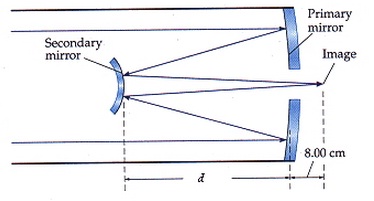Q1. A Cassegrain astronomical telescope employs two mirrors to form the image. The bigger (concave) objective mirror consists of a focal length f1 = +51.5 cm. A small convex secondary mirror is mounted d = 43.5 cm in front of primary. As shown in the figure below, light is reflected from the secondary via a hole in the center of the primary, thus forming a real image 8.00 cm behind the primary mirror. Determine the radius of curvature of the secondary mirror?

Q2. An aluminum rod 15 cm in length is heated from 10o Celsius to 50o Celsius. Determine the change in length?
a) 15 cm
b) 8 cm
c) 6 cm
d) None of above.
Q3. Illustrate the Kepler’s first law of planetary orbits?
a) The planets move on ellipses with Sun at the center of ellipse.
b) The planets rotate around the Earth.
c) The position of planets foretells the future.
d) The planets move on ellipses with the Sun at one of foci.
Q4. In order to wholly melt a material,
a) Heat should be added up to bring the material to the melting temperature and then the latent heat of fusion should be added to alter the phase.
b) Heat should be added to make the object expand to the melting volume.
c) No heat requires to be added.
d) Stir while adding up the heat.